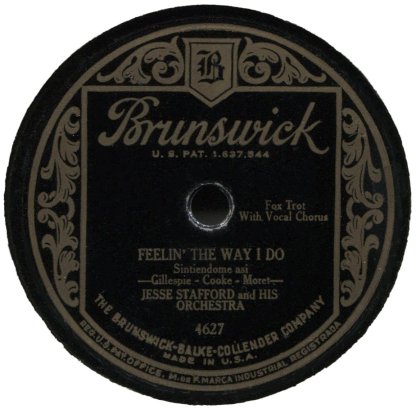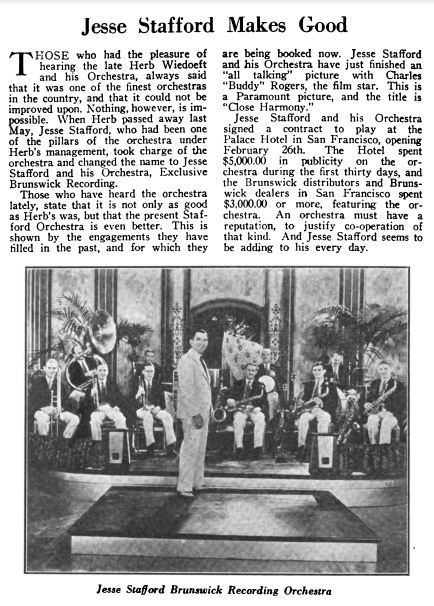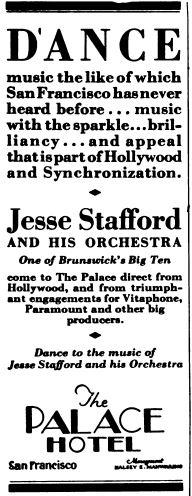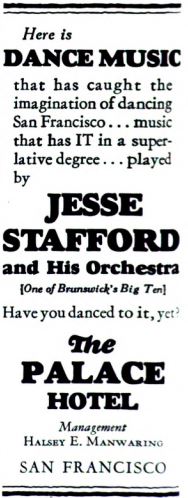
“Feelin’ The Way I Do”
Jesse Stafford and His Orchestra; Charley Blane, vocal
(Brunswick 4627) September 4, 1929
“Last Night Honey”
Jesse Stafford And His Orchestra; Charlie Blane, vocal
(Brunswick 4627) September 4, 1929
Here is another record from the Edward Mitchell collection.
Trombonist Jesse Stafford was the associate leader and part owner of the West Coast-based Herb Wiedoeft band. When Wiedoeft was killed in a traffic accident in May, 1928, Stafford took over as the band’s leader and changed its name to the Jesse Stafford Orchestra.
The band’s success continued under Stafford’s leadership. Within two months of Wiedoeft’s death, the band was back in the recording studio for Brunswick, for which it had been making records since 1923. Stafford and the band also appeared in the 1929 talking picture Close Harmony.
In February 1926, the band landed a long-term engagement at San Francisco’s posh Palace Hotel. According to an article in the June 1929 edition of The Metronome, the hotel spent $5,000 on publicizing the orchestra during the first month of the engagement. (See images below) If that amount – the equivalent of about $90,200 in 2024 currency – is true, that is pretty remarkable as an indication of the size of crowds such bands could attract during the 1920s and how lucrative it could be for the more successful ones.
As with other bands, it was undoubtedly impacted by the onset of the Great Depression.
The band’s last recording session was in May 1930. However, two records made in 1931 were credited to the band even though it did not participate in the recording sessions. On May 19, 1931, two sides were recorded by the Art Kahn Orchestra, issued on Brunswick 6126 as Jesse Stafford and His Orchestra. Another recording session on August 18th, led by Bill Challis, resulted in two sides issued on Brunswick 6171 credited to Jesse Stafford and His Orchestra.
I do not know why the two records by other bands were issued under the Stafford’s name. The use of recording pseudonyms was extremely common back then. Perhaps Brunswick thought that issuing the records under Stafford’s name might have resulted in increased sales – though, if so, undoubtedly, Stafford would have had to have given his approval.
One possibility that occurs to me is based on the fact that both 1931 recording sessions took place in Brunswick’s main studios in New York City and the studio’s documentation initially indicated that band was to be the label’s in-house studio orchestra led by Victor Young. However, on both sessions, Victor Young’s name was crossed out and replaced by a handwritten notation indicating the bands as being led by Art Kahn and Bill Challis respectively.
My thought is that it is perhaps possible that, to save the expense of Stafford’s band having to travel to Brunswick’s Los Angeles or New York studios, Stafford might have sent the band’s arrangements to New York so that whichever local musicians were at hand could replicate the Stafford Orchestra’s sound.
Record sales were profoundly impacted by the Depression, leaving all record labels fighting for survival. And, even if Brunswick had been willing to pick up the travel expenses, the money the band would have made from the recording sessions might not have been enough to justify the amount lost by any missed live engagements or broadcasts during the trip.
I could not find through quick research how far into the 1930s or beyond Stafford’s band carried on. Because of slow record sales, there were several bands whose records sold well during the 1920s and continued performing well past the 1930s but stopped recording during the Depression and did not resume until the latter part of the 1930s decade, if at all.
Stafford died from a heart attack while playing golf in 1947 at age 54.
Before discovering this record in Eddie Mitchell’s collection, I was not familiar with either of the songs. But I noticed that one of the composers of “Feelin’ The Way I Do” was Neil Moret, one of several pen names used by Charles N. Daniels who had composed several very nice ragtime era songs such as “Hiawatha,” “Silver Heels,” and “Poppies.”



